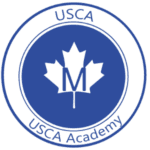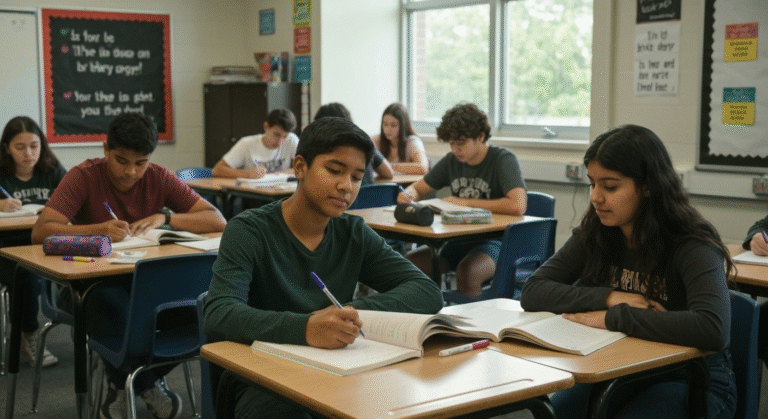Key Highlights
- The Ontario Secondary School Diploma (OSSD) is what you need to graduate from high school in the province.
- In Ontario secondary schools, students must get 30 high school credits, pass a literacy test, and do 40 community involvement hours.
- The Ontario education system changed by ending the old fifth year of high school, which used to be called the Ontario Academic Credit (OAC) year.
- Private high schools give students flexible ways to get their credits. Classes are small, and there is personalized help for each student.
- The Ontario Secondary School Diploma is known all over the world. It helps students get into universities in Canada and outside the country.
Introduction
Moving to a new secondary education system can be challenging for parents and students from other countries. Understanding how Ontario academic credits work is crucial for exploring high school options in Ontario. The Ontario secondary school system prepares students for college or other post-secondary plans, requiring the successful earning of specific credits. In this guide, you will discover key information about the Ontario Secondary School Diploma, including the credit rules to follow. You’ll also learn how private high schools can assist you in achieving your goals within the secondary education system.
Understanding Ontario Academic Credits
The academic credit system is the base of how high school education works in Ontario. In this system, students get one credit for each course they pass. These credits help them work toward their diploma. The way the system is set up now is simple. In the past, there was a fifth year of secondary school called Ontario Academic Credit (OAC), which worked differently in the lower grade levels.
Knowing about this change helps people see how the new curriculum came to be. Right now, students follow a four-year plan, and some may opt to take an extra year of high school if needed. The Ministry of Education made this program to help students get ready for what comes after secondary school. The next parts explain more about credits in high school and how students earn them today.
What Are Ontario Academic Credits?
In the past, Ontario Academic Credits (OAC) referred to Grade 13 courses, which offered the highest level of secondary education and were crucial for university admission the elimination of the OAC year meant students needed six OAC-level courses to qualify. The fifth year provided advanced lessons, sometimes considered equal to first-year university studies. With the formal elimination of OACs in 2003, Ontario high schools moved to a four-year system, incorporating more challenging material into earlier grades. Although OAC credits are no longer used, their legacy remains as a symbol of Ontario’s commitment to strong university preparation within its high school education system.
How Credits Are Earned in High School
In Ontario high schools, during your OAC year, you earn credits by completing courses. Each full-year course gives you one credit. To graduate and get an Ontario secondary school diploma, you need 30 credits, split into compulsory and optional credits.
- 18 Compulsory Credits: Required courses in subjects like English, math, science, and history, set by the Ministry of Education.
- 12 Optional Credits: Chosen from subjects such as arts, business, technology, or extra sciences, based on your interests or future goals.
Most students complete these credits in four years. Every course has a code that shows the subject, grade, and course type.
The Ontario Secondary School Diploma (OSSD) Framework
The Ontario Secondary School Diploma (OSSD) is what you get when you finish secondary school in Ontario. This official diploma shows you have completed the high school program. Post-secondary schools in Canada and other countries accept the OSSD. Getting an Ontario Secondary School Diploma is not only about collecting credits. The secondary school diploma follows a plan that helps you get ready for what comes next.
To receive the OSSD from the Ontario Ministry of Education, there are some diploma requirements. You have to finish a certain number of credits. You also need to pass a literacy test, and do some work in your community. Now, let’s talk more about what makes up the Ontario secondary school diploma.
Credit Requirements for Graduation
The Ontario Secondary School Diploma (OSSD) requires students to earn 30 credits to graduate, including the secondary school honours graduation diploma requirements. Of these, 18 are compulsory, covering core subjects that build foundational skills, while 12 are optional, allowing students to explore interests or focus on future goals. This standardized 30-credit, four-year model replaced the Ontario Academic Credit, aligning Ontario with other North American education systems and ensuring rigorous academic standards. Below is a breakdown of the compulsory credits needed for the OSSD:
|
Subject Area |
Number of Credits |
|---|---|
|
English |
4 |
|
Mathematics |
3 |
|
Science |
2 |
|
Canadian History |
1 |
|
Canadian Geography |
1 |
|
Arts |
1 |
|
Health & Physical Education |
1 |
|
French as a Second Language |
1 |
|
Civics and Career Studies |
1 |
|
Group 1, 2, & 3 Courses |
3 |
Literacy Test & Community Service Hours
- Ontario secondary school students must pass the Ontario Secondary School Literacy Test (OSSLT) in Grade 10, which checks reading and writing skills based on what is taught until the end of the days of schooling in Grade 9.
- Students also need to complete at least 40 community involvement hours, which can include volunteering for non-profits, joining community events, or supporting local causes.
- These requirements help students develop literacy skills, explore career options, and become active in their communities, making them key parts of the Ontario Secondary School Diploma (OSSD) program.
How Private High Schools Like USCA Academy Help Students Earn Credits
For many families, choosing a private high school in Mississauga can be an effective path to earning an OSSD. Schools like USCA Academy in Mississauga provide a supportive and structured environment for learning. Their dedicated teachers assist students in earning high school credits efficiently while promoting academic excellence in Ontario. This personalized approach caters to students with specific university goals or those seeking an education tailored to their individual needs. In the following sections, we will explore how private high schools like USCA Academy fulfill this commitment to students pursuing high school education and credits in Ontario.
Academic Flexibility & Small Class Sizes
One major advantage of private high schools is academic flexibility. Unlike public schools with rigid schedules, private schools in Ontario offer more class choices and open scheduling, letting you earn credits in a way that suits your learning style, including courses offered at the OAC level. You can finish your diploma faster or take extra time for challenging subjects. This approach helps all students meet graduation requirements.
Small class sizes also boost academic excellence. With fewer students per teacher, you receive more personal attention and support. This encourages active participation and allows teachers to meet individual needs.
Benefits of this model include:
- Personalized feedback on assignments and progress.
- More chances for one-on-one help.
- A close school community, where students can ask questions easily.
USCA Academy’s Credit Planning Approach
USCA Academy offers a detailed credit planning approach to help students achieve their academic goals. Here’s how it works:
- Guidance counselors collaborate with students and parents to create a personalized plan based on skills, interests, and future aspirations, such as attending top universities in Canada or abroad.
- Each plan ensures students choose the required courses and course codes aligned with Ontario’s official curriculum, guaranteeing all credits earned are recognized for graduation and university admission.
- This careful guidance removes stress and uncertainty, helping students stay focused, confident, and on track to fulfill their high school and post-secondary ambitions.
Credit Transfer Options for International Students
For international students in Ontario, understanding how past schooling fits into the new high school system is crucial. The Ontario government has established clear credit transfer for high school students options to ensure that prior learning is recognized, facilitating a smoother transition into an Ontario high school. Private schools play a vital role by offering tailored support to help international students obtain the credits they deserve. The following sections will provide detailed information on how credit transfers function and the assistance available to students throughout this process, ensuring that you are well-informed and prepared for your educational journey in Ontario.
Transferring Credits from Abroad
If you are an international student, you can have your high school courses from your home country assessed for equivalency through the Prior Learning Assessment and Recognition (PLAR) process. This helps you earn credits toward your Ontario high school diploma without repeating subjects you’ve already mastered, especially in a context similar to the double cohort year where students face unique challenges. Schools like USCA Academy specialize in guiding international students through credit transfers, evaluating transcripts, and creating personalized study plans.
- PLAR matches your previous coursework with Ontario curriculum requirements.
- Schools such as USCA Academy review your academic records for credit transfer.
- You can enter the right grade, complete needed credits, and graduate or apply to universities efficiently.
Support Systems for International Learners
Adjusting to Ontario’s education system can be challenging for international students, so having the right support is essential. Many private schools offer programs to help students succeed academically and adapt to life in Canada, especially after the formal elimination of the Ontario Academic Credit. These support systems explain the credit system and help learners feel comfortable in their new environment.
English language learners can access special lessons to build their language skills, making it easier to participate in class and meet Ontario curriculum standards, as emphasized by Steven Del Duca.
Other big supports are:
- Academic advisors to guide course selection and university applications.
- Cultural programs to ease the transition to Canadian life.
- Peer tutoring and mentorship for academic and personal growth.
These supports create a welcoming environment for international students in Ontario.
Preparing for University with Ontario Academic Credits
Earning high school credits in Ontario is the main way to get ready for university preparation in Canada, allowing students to earn high school credits in Ontario while developing necessary skills. The OSSD gives you the skills and knowledge that you need for tough university programs. In high school, every credit you get takes you one step closer to your goals. The courses you pick will decide if you can get into Ontario universities or other Canadian universities.
You need to plan well so your high school diploma matches what you want to do after school. Let’s look at how you can match your high school credits, which can have different credit values, to your hope of going to university and see how other people reached their goals.
Aligning Credits with Post-Secondary Goals
Choosing the right courses is a big step when you want to get ready for university preparation in Canada, including community colleges. When you want to get into certain degree programs, you need to have some necessary prerequisite courses done in high school. For example, if you want to study engineering, you will have to take senior math and science classes. If you want a business degree, you may need advanced math subjects like advanced functions and calculus.
This means you have to plan your courses with care in the province of Ontario. Do your research about the universities you want to apply to and the programs you like. Do this early while you are still in high school. This way, you can pick the right extra subjects that go along with your required ones.
Key steps to stay on the path for your goals in high school and secondary education include:
- Find out which path you want to take after graduation.
- Look into which classes you need before you can apply to your first-choice degree programs.
- Talk to your guidance counselor, so you and they can put together a plan that lets you meet all these needed subjects.
When you connect your credits to what you want out of your future, you make your high school transcript stand out. This can help you get into more doors as you move forward.
Conclusion
To sum up, it is essential for parents and international students to understand Ontario academic credits. A strong grasp of secondary school workings greatly aids in student success as a result of the double cohort. The Ontario Secondary School Diploma (OSSD) provides a structured approach for earning credits. Private institutions like USCA Academy offer valuable support through small class sizes and tailored credit planning. This flexible secondary school environment enhances study choices and aligns with future university aspirations. As you explore options for a secondary school diploma, remember that each decision impacts your child’s future. For questions or assistance, please contact us for personalized guidance and support.
Frequently Asked Questions
1. Can Ontario academic credits be earned through summer school or night school?
Yes, you can get high school credits in other ways. School boards and private schools have programs like summer school, night school, and online classes for students who are at least 16 years of age. These let people catch up, improve marks, or take extra courses. You can use them to meet graduation requirements or get ready for college.
2. Are Ontario academic credits recognized by international universities?
Yes, the Ontario Secondary School Diploma is trusted all over the world. Many places like the United States, the United Kingdom, and Australia let students use this secondary school diploma to apply to university, including top institutions like the University of Toronto. Most universities there accept this Ontario secondary school qualification. It helps students move on to secondary education in lots of different countries. The Ontario secondary school diploma is a good step if you want to study and get into a college or university anywhere, not just in Canada.
3. Do extracurricular activities contribute to Ontario academic credits?
Standard clubs or sports do not give you academic credits. The Ontario curriculum lets students earn credits by taking part in special programs like cooperative education and OAC courses. This program offers real work experience. These credits are different from the 40 hours of community involvement activities that everyone needs to graduate.










